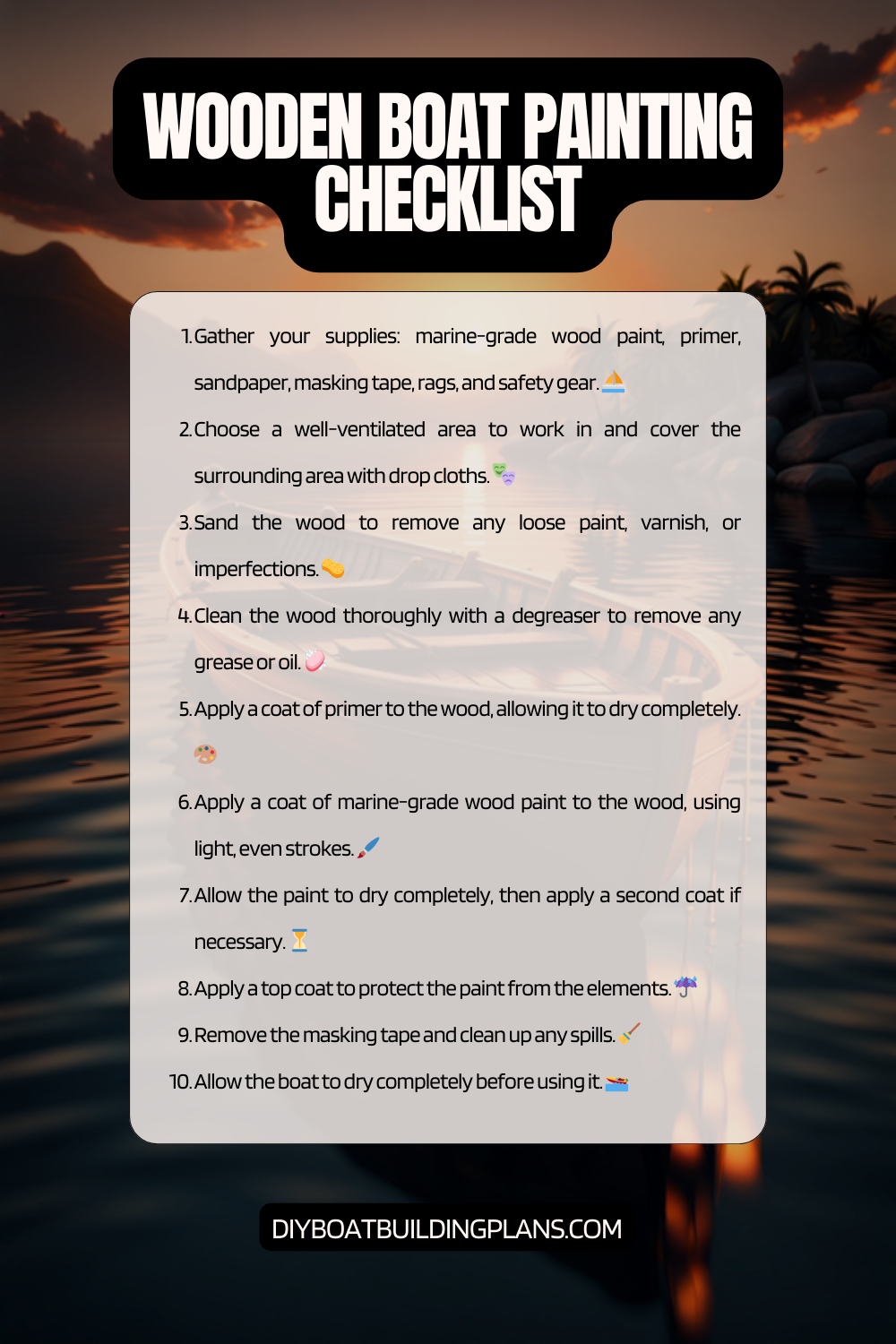Overview of Wooden Boat Painting Tips
Maintaining the paint job on a wooden boat is of utmost importance. Not only does it enhance the aesthetic appeal of the vessel, but it also serves as a protective layer against the harsh elements of the water. A well-painted wooden boat not only looks beautiful but also has a longer lifespan. The paint acts as a barrier, preventing water from seeping into the wood and causing rot or decay. Additionally, a well-maintained paint job can increase the resale value of your boat. So, whether you are a proud owner of a classic wooden boat or have recently acquired one, it is crucial to understand the significance of proper painting techniques.
Key Takeaways
- Choosing the right paint is crucial for a successful wooden boat painting project.
- Proper preparation, including sanding and priming, is essential for a long-lasting paint job.
- Applying paint with the right techniques and tools can make a big difference in the final result.
- Regular maintenance is necessary to keep your wooden boat looking great.
- Avoid common mistakes, such as rushing the process or using the wrong type of paint, to ensure a successful painting project.

Choosing the Right Paint for Your Wooden Boat
When it comes to choosing the right paint for your wooden boat, there are several factors to consider. Firstly, you need to select a paint that is specifically designed for use on wooden surfaces. Marine-grade paints are highly recommended as they are formulated to withstand the constant exposure to water and UV rays. These paints are often oil-based or epoxy-based, providing excellent durability and protection.
Another important consideration is the type of finish you desire. Glossy finishes offer a high shine and are easier to clean, but they may require more maintenance in the long run. On the other hand, matte or satin finishes provide a more natural look and are less prone to showing imperfections.
Preparing Your Wooden Boat for Painting
Before diving into the painting process, it is crucial to properly prepare your wooden boat’s surface. This involves cleaning and removing any old paint, filling cracks and holes, and sanding the surface to create a smooth canvas for painting.
Start by thoroughly cleaning the boat using a mild detergent and water solution. This will remove any dirt, grime, or salt residue that may be present on the surface. Once clean, use a scraper or sandpaper to remove any loose or peeling paint. It is essential to remove all old paint to ensure proper adhesion of the new paint.
Next, inspect the boat for any cracks or holes. These should be filled using an appropriate wood filler or epoxy. Allow the filler to dry completely before proceeding to the next step.
Sanding Techniques for Wooden Boat Painting
| Sanding Technique | Description | Advantages | Disadvantages |
| Hand Sanding | Sanding by hand using sandpaper or sanding blocks. | Allows for greater control and precision. Can be done in tight spaces. | Can be time-consuming and tiring. May not be as efficient as power sanding. |
| Power Sanding | Sanding using a power tool such as an orbital sander or belt sander. | Can be faster and more efficient than hand sanding. Can cover larger areas. | May be more difficult to control. Can create more dust and mess. |
| Wet Sanding | Sanding using water to lubricate the sandpaper and reduce dust. | Produces a smoother finish. Reduces dust and mess. | May require more time and effort. Can be more difficult to control. |
| Dry Sanding | Sanding without any lubrication or water. | Can be faster and more efficient than wet sanding. Can be easier to control. | Produces more dust and mess. Can create scratches or marks on the surface. |
Sanding is a crucial step in the wooden boat painting process as it helps create a smooth and even surface for the paint to adhere to. It also helps remove any remaining traces of old paint and prepares the wood for optimal absorption of the primer and paint.
When sanding a wooden boat, it is important to use the right type of sandpaper. Coarse-grit sandpaper should be used initially to remove any rough spots or imperfections. As you progress, switch to finer-grit sandpaper to achieve a smoother finish. Always sand in the direction of the wood grain to avoid causing damage or creating visible scratches.
Applying Primer to Your Wooden Boat
Priming your wooden boat is a crucial step that should not be skipped. The primer acts as a bonding agent between the wood and the paint, ensuring better adhesion and longevity of the paint job. It also helps seal the wood, preventing moisture from penetrating and causing damage.
There are different types of primers available for wooden boats, including oil-based and epoxy-based options. Oil-based primers are commonly used and provide excellent adhesion and protection. Epoxy-based primers are more expensive but offer superior durability and resistance to moisture.
When applying primer, it is important to follow the manufacturer’s instructions regarding drying times and application techniques. Use a high-quality brush or roller to ensure even coverage and avoid leaving brush marks or streaks.
Tips for Applying Paint to Your Wooden Boat
Choosing the right brush or roller is essential when it comes to applying paint to your wooden boat. For larger areas, a high-quality roller can provide quick and even coverage. However, for smaller or more intricate areas, a brush is often the better choice as it allows for better control and precision.
When applying paint, it is important to use smooth and even strokes. Start from one end of the boat and work your way towards the other, overlapping each stroke slightly to ensure even coverage. Avoid applying too much pressure as this can lead to drips and runs. It is better to apply multiple thin coats rather than one thick coat to achieve a professional-looking finish.
Painting Techniques for Wooden Boat Detailing
Detailing a wooden boat requires a different set of techniques compared to painting larger areas. When it comes to intricate details, such as trim or decorative elements, it is important to choose the right brush or tool for the job. Fine-tipped brushes or small foam brushes are often used for precise detailing.
To achieve a professional-looking finish, take your time and work slowly. Use steady hands and apply the paint with care, ensuring that it does not bleed into adjacent areas. If necessary, use masking tape to create clean lines and prevent any accidental smudging.
Maintaining Your Wooden Boat Paint Job
Regular maintenance is key to keeping your wooden boat’s paint job looking new and vibrant. This includes routine cleaning, inspection for any signs of damage or wear, and touch-ups as needed.
To clean your boat, use a mild detergent and water solution along with a soft brush or sponge. Avoid using abrasive cleaners or harsh chemicals as they can damage the paint. Regularly inspect the paint job for any signs of peeling, cracking, or chipping. If any damage is detected, promptly address it by sanding the affected area, applying primer, and touching up with paint.
Download over 500 Boat Plans. Click on the link below.
-->Click Here<--
Common Mistakes to Avoid When Painting a Wooden Boat
While painting a wooden boat may seem straightforward, there are common mistakes that can be easily avoided with proper knowledge and preparation. One common mistake is rushing the process. Painting a wooden boat requires patience and attention to detail. Take your time, follow the proper steps, and allow sufficient drying time between coats.
Another mistake is neglecting proper surface preparation. Failing to clean, sand, or prime the surface adequately can result in poor adhesion and a shorter lifespan for your paint job. Additionally, using low-quality paint or tools can lead to subpar results. Invest in high-quality materials to ensure a long-lasting and professional-looking finish.
Tools and Equipment Needed for Wooden Boat Painting
To successfully paint a wooden boat, you will need a variety of tools and equipment. These include brushes or rollers, sandpaper of various grits, scrapers, wood filler or epoxy, primer, and high-quality marine-grade paint. It is important to choose the right tools for the job to achieve the best results.
When selecting brushes or rollers, opt for those specifically designed for use with oil-based paints. These brushes are often made of natural bristles or synthetic materials that provide smooth application and even coverage. For sanding, choose sandpaper with different grits ranging from coarse to fine to achieve the desired smoothness.
Wooden Boat Painting Checklist

Conclusion – Wooden Boat Painting Tips
Painting a wooden boat requires careful planning, preparation, and execution. By understanding the importance of maintaining a well-painted wooden boat and choosing the right paint and tools, you can ensure a long-lasting and beautiful finish. Proper surface preparation, including cleaning, filling cracks, and sanding, is crucial for optimal adhesion of the paint. Applying primer and paint with the right techniques and tools will result in a professional-looking finish.
Regular maintenance is key to preserving your wooden boat’s paint job. By routinely cleaning, inspecting for damage, and addressing any issues promptly, you can keep your boat looking new for years to come. Avoid common mistakes such as rushing the process or neglecting proper surface preparation. Invest in high-quality tools and materials to achieve the best results.
Taking on a wooden boat painting project can be a rewarding experience. With the right knowledge, techniques, and tools, you can transform your boat into a stunning masterpiece that will be admired by all who see it. So, embrace the challenge and enjoy the process of painting your wooden boat.
FAQs – Wooden Boat Painting Tips
What are wooden boat painting tips?
Wooden boat painting tips are techniques and guidelines that help in achieving a smooth and long-lasting finish on wooden boats. These tips include surface preparation, paint selection, application techniques, and maintenance.
Why is it important to paint a wooden boat?
Painting a wooden boat is important because it protects the wood from moisture, UV rays, and other environmental factors that can cause damage. It also enhances the appearance of the boat and increases its resale value.
What are the steps involved in painting a wooden boat?
The steps involved in painting a wooden boat include surface preparation, selecting the right paint, applying the paint, and maintaining the finish. Surface preparation involves cleaning, sanding, and filling any cracks or holes. The right paint should be selected based on the type of wood and the environment the boat will be used in. Applying the paint involves using the right tools and techniques to achieve a smooth finish. Maintaining the finish involves regular cleaning and touch-ups as needed.
What type of paint should be used on a wooden boat?
The type of paint that should be used on a wooden boat depends on the type of wood and the environment the boat will be used in. Generally, marine-grade paints that are designed for use on boats are recommended. These paints are durable, waterproof, and resistant to UV rays.
What are some common mistakes to avoid when painting a wooden boat?
Some common mistakes to avoid when painting a wooden boat include not properly preparing the surface, using the wrong type of paint, applying too much or too little paint, and not allowing enough time for the paint to dry between coats. It is also important to follow the manufacturer’s instructions and use the right tools and techniques for the job.



